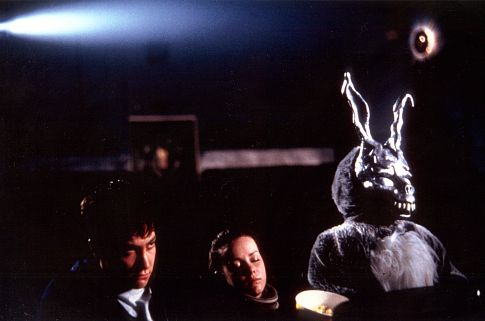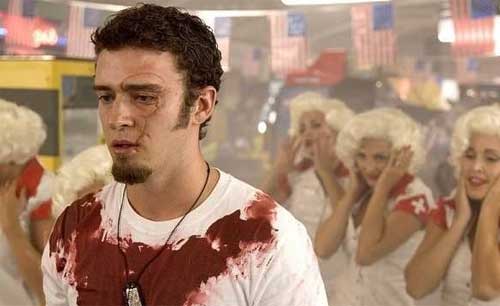Title: Perfect Blue
Director: Satoshi Kon
Released: 1997
Starring: Junko Iwao, Rica Matsumoto, Shinpachi Tsuji,
Masaaki Okura, Yosuke Akimoto, Yoku Shioya, Hideyuki Hori, Emi Shinohara,
Masashi Ebara, Kiyoyuki Yanada, Toru Furukawa, Akio Suyama
Plot: Mima , a member of a J-pop group “CHAM!” decides to
pursue a career as an actress, displeasing her fans especially her stalker Me-Mania
(Okura). Now finding herself the target of threatening fax’s and mail bombs,
things only get stranger when she discovers a website call “Mima’s Room”
documenting her life if she was still with the band, as Mima finds her world
being turned upside down as she is pushed to the brink of her own sanity.
Review: One of the great masters of Japanese animation, the
career of Satoshi Kon would be tragically cut short when he lost his battle with
pancreatic cancer, but it would be a stunning body of work he would leave us
with, if perhaps sadly also one of the most overlooked.
Here he makes his directorial debut with a Hitchcock-esq
thriller and which I frequently like to use as reference point when it comes to
arguing the fact that anime is more than cutsy characters, tentacle porn and
schoolgirl fan service which frequently seems to the opinion shared by those
not familiar with the genre outside of the parts which regularly gain
mainstream exposure. True this film is not without its shocking moments with several
bloody murders and a scene were Mima is forced to act out a nightclub group
rape. However this is more than shock value as it also serves to mark out a
snapping point for Mima and her already fragile psyche, as she soon starts
questioning what is real and what is fantasy, while Kon leaves the audience to
question the same things for themselves, yet resisting the urge to take the
audience down a Lynch style rabbit hole.
Based on the novel of the same name by Yoshikazu Takeuchi,
who also wrote the original screenplay, which Kon was unhappy with and ultimately
would have the script reworked by Sadayuki Murai with Takeuchi’s permission
providing that the three elements of Idol, Horror and Stalker were kept
Takeuchi was happy for Kon to make any changes he liked. Interestingly this
film was originally intended to be filmed as live action adaptation only for
the film to be turned into a OVA when the production studio was damaged during
the 95 Kobe earthquake. A live action version directed by renown pink film
director Toshiki Sato would be finally
released in 2002, which reportedly is a lot closer to the source novel than
this film.
A griping film throughout, the film though is a lot deeper
than your usual psychological thriller, as while most thrillers would be content
to just play off the mystery of “Mima’s Room”, here Kon’s focus on the changing
personality from Virginal pop idol to driven actress willing to do more and
more to ensure that she makes it as an actress, even if it means shattering the
image her fans have on her, with her agreement to film the aforementioned rape
scene only being the start of the slow reveal of her much darker side.
At the same time Kon shows equal attention to the supporting
characters who all provide their own piece of the puzzle, from Mima’s office
Manger Tadokoro (Tsuji) who pushes Mima into increasingly risque situations
which he convinces is for the good of her career regardless of the pressure it
puts on her already fragile psyche through to the obsessed and grotesque stalker Me-Mania who plasters
his walls with images of Mima’s pop idol form which in one memorable scene even
speak to him. Kon though is equally mindful of the smaller details which often
prove as a result to be just as memorable, such as an actor involved in filming
the rape scene apologising to Mima during a break between takes.
The animation is crisp and clean throughout, with Kon
choosing to avoid the more traditional large eyed anime style, instead for a
more realistic style as seen with the wide range of character designs and while
it might not have the wow factor that many have come to expect thanks to the
releases of Studio Ghibli this is still visually a nice anime to look at, with
the movement of the characters being especially spot on as especially
highlighted during the ice pick murder sequence involving a length chase around
the victims apartment.
Unquestionably this would be a memorable debut film from Kon
and one which he would continue to build on even if he would choose to explore
other genres with the films which followed, he would thankfully return to
explore the themes here further with the series “Paranoia Agent”. On its own merits though this film really is a
benchmark in Japanese animation aswell as also providing the inspiration for Darren
Aronofsky’s “Black Swan”, making it only the more of a shame that it hasn’t
been given the same recognition as the likes of the legendry “Akira” or “Ghost
In The Shell” and like “Wings of Honneamise” has resulted it in being missed
out by the more casual anime viewers which is something of a shame, especially
when it is the sort of film which serves to highlight the range of styles which
Anime covers.






















No comments:
Post a Comment